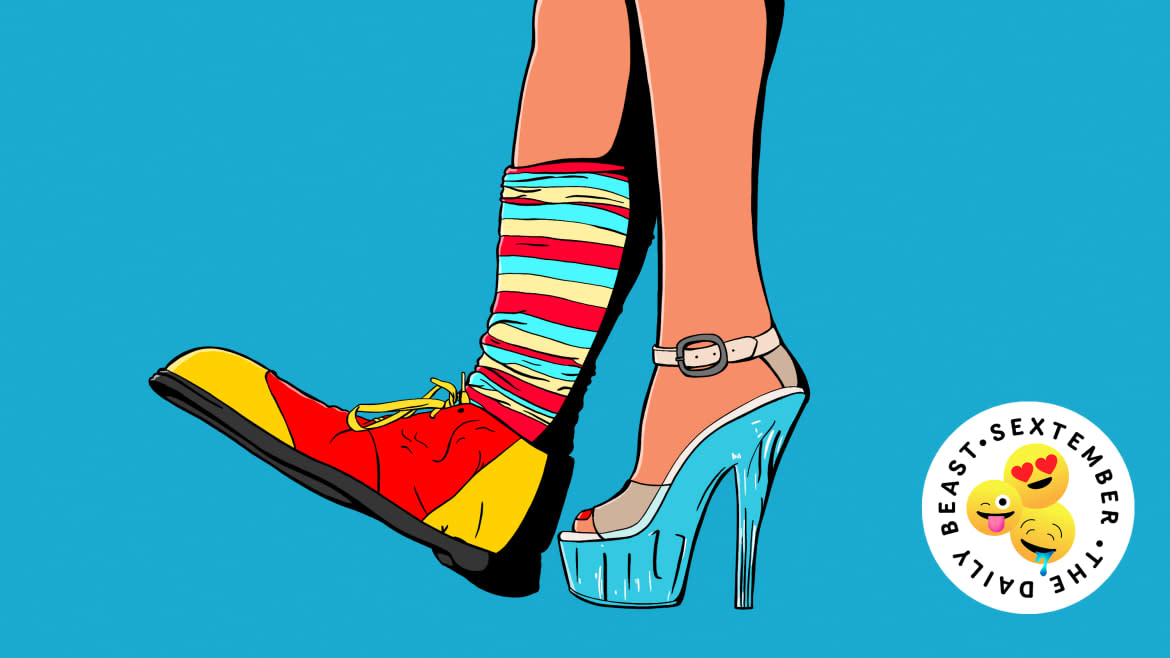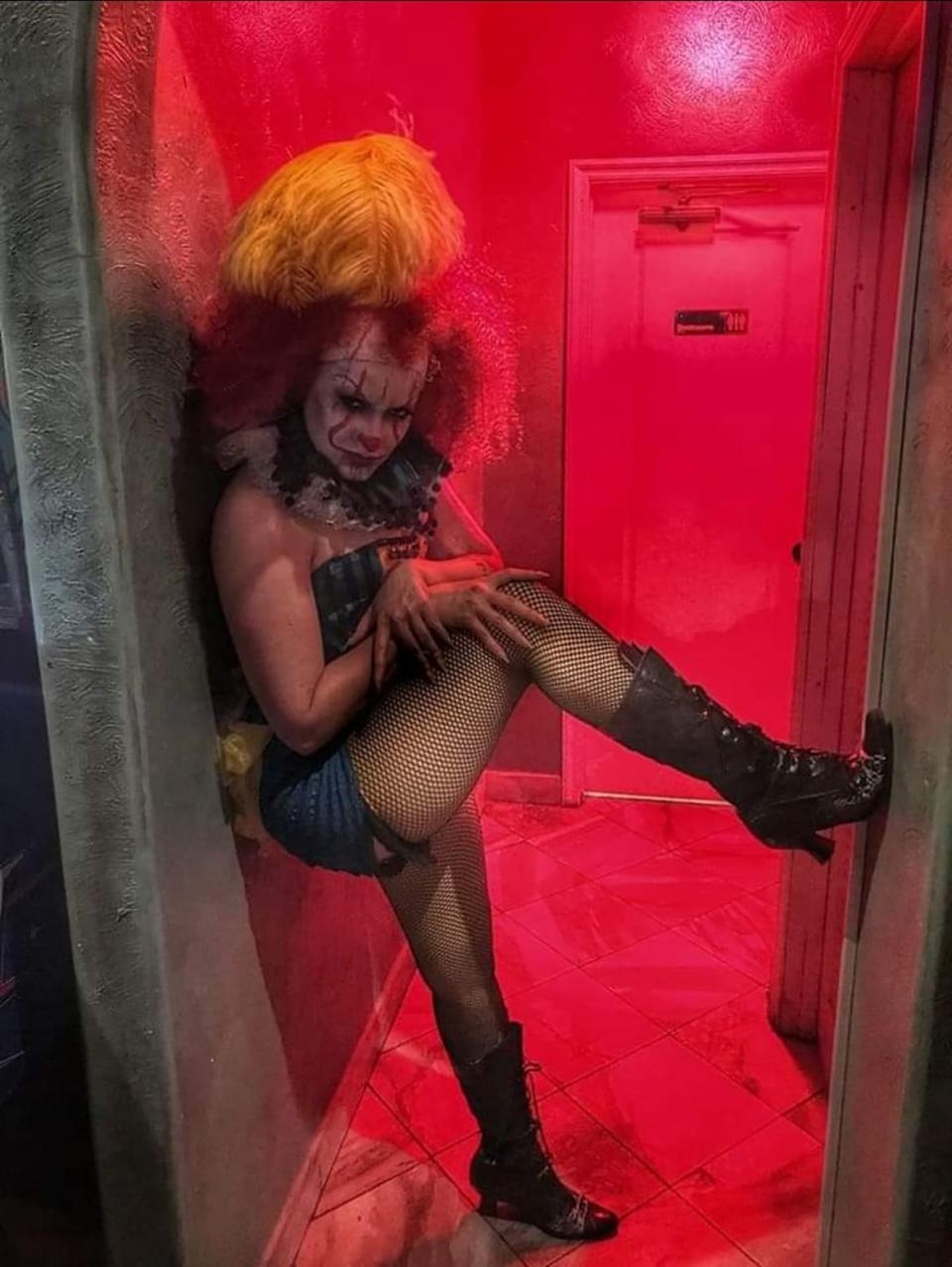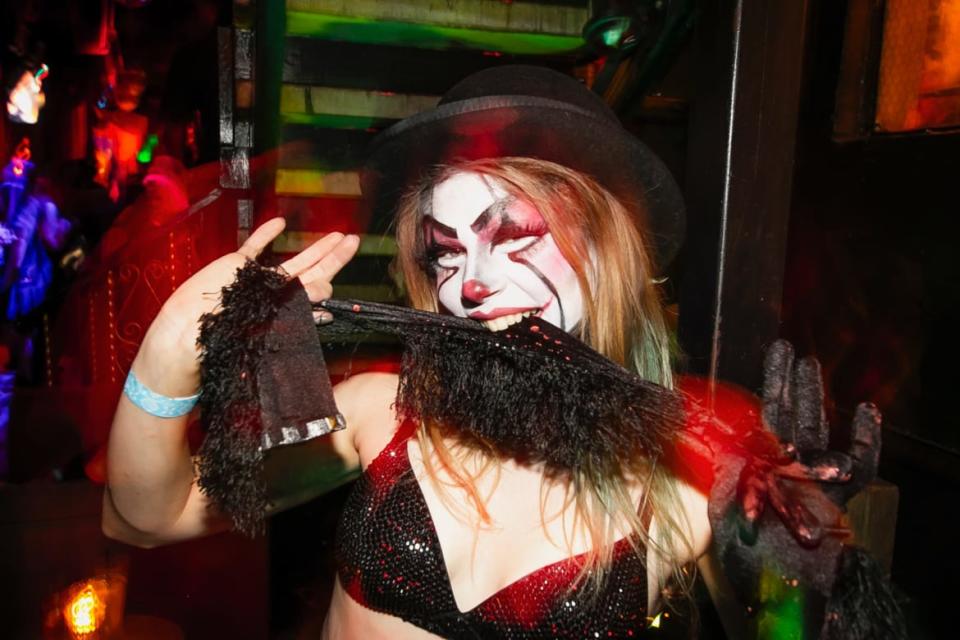Why We Became Clown Sideshow Strippers

It’s Saturday night at a Los Angeles strip club, and a pigtailed clown with a face full of greasepaint is twerking on a bed of Lego bricks. The crowd is going berserk, some clapping and cheering and throwing dollar bills on-stage as the clown stripper continues to play coquette, taking off their top and striking a series of sensual poses with cartoonish glee. But the majority of onlookers just stare in open-mouthed horror, covering their eyes when it’s clear the clown stripper is about to do the splits. And as soon as it happens, at least one person lets out a bloodcurdling scream. Another looks as if they’re about to pass out.
“People have those kinds of reactions all the time,” said Seraphina, who usually performs their signature bed of Lego act under the stage name Demonic Cupcake. And as they also noted, incorporating eye-popping sideshow stunts into already-sensual performances will usually make a gig even more lucrative, with some people even handing them $20 bill while begging, “‘Please don’t.’”
They stifled a laugh, “And I just take it from their hand, look them in the eye, and stomp really hard.”
As a clown stripper, Seraphina is part of a community of adult entertainers who combine striptease with sideshow acts that range from sword swallowing to shoving 5-inch nails up their noses—an act known as “human blockhead.”
Covered in clown makeup and flamboyantly dressed, they’re burlesque dancers with a twist: a surprising ability to be hot while performing terrifying, titillating, and often extremely painful tricks. And the end result tends to be packed pop-up nights that draw out the novelty-seekers and fetishists alike, intrigued by the crazy promise of a sexy clown deep-throating a 4-foot balloon.
That said, clowning, sideshow, and stripping have long been deeply intertwined, with a shared history dating back to 19th century vaudeville. To sell tickets, some showrunners would include racy “burlesque” segments with scantily clad women performing slapstick comedy routines, which soon made its way into the world of traveling carnivals and freak shows. So despite modern burlesque typically eliciting images of vintage glamor and diamond-soaked pageantry, clown stripper Vita DeVoid said that it can also just as easily be “a sloppy crust punk doing clown stripping, eating balloons, and snapping mousetraps on her tongue.”
But what exactly creates a clown stripper? Well for one, the circus has always had a reputation for attracting outsiders like DeVoid, who recalled growing up “in a very boring small village surrounded by rednecks and spiteful conservatives.”
“It was horrific. I got my ass beat constantly, because I was a little different and the only goth in high school,” she said, explaining that her only respite was “hiding in my tiny room with my itty bitty TV to watch old vaudeville and comedy stuff.”

However, it wasn’t until she moved to Tampa to work as a stripper that DeVoid started to train with a local enclave of off-season circus entertainers, who taught her how to “poker face” through the pain of being a human pin cushion and sticking her hand inside a bear trap. From there, she was able to feel the power of “creating a person you want to be,” which came with the brave ability to jolt people out of the drudgery of everyday existence, whether they found it disturbing, hot, or just flat-out interesting. And even better, she appreciated the ability to separate herself from this on-stage persona, knowing that she was always ultimately able to “put down the mask of a clown” after a show.
“It’s your little shell,” she said of her chosen method of creative escapism. “You’re still deep in there, but you’re presenting this crazy wild character.”
In Kaylith Von Kola’s case, though, the circus was both a mental and a physical escape. Coming from a “rough background,” they decided as a teenager that “it was more conducive for me to be hanging out with a traveling carnival.”
“It was honestly safer for me at the time,” Von Kola continued. “And I could learn how the games work, lend a hand, and just have a place to be where I could do something productive with people who were looking out for me and protecting me.”
Von Kola added that their love of the circus was later deepened by the now-defunct Venice Beach Freakshow, which she called “a beautiful place of acceptance” after “having been an outsider most of my life.” After all, it’s unsurprising that a group of people who exist beyond mainstream social norms would band together and develop a strong loyalty towards their peers, which Von Kola also demonstrates by continuing to be a vocal supporter of the clown stripper community, despite personally gravitating towards different artforms.

Not only that, but their interest in sideshow helped curb their struggle with self-harm, as Von Kola remembering herself thinking that “‘I’ll learn how to do this instead, because it hurts, but it’s not that bad.’”
“I would pull myself out of my mind and was able to raise my pain tolerance, which ended up being a much healthier thing that got me away from self harming in negative ways,” she said, adding they’d use their bed of nails for “pain focused meditation.”
“So yeah, they’re things that beat my body up, but it’s for a better purpose than before,” Von Kola noted. And now, they’re able to better focus on putting together intensive festival strip shows as KLIC-B8, which feature comedic narration and daredevil sideshow stunts, performed with unique looks that draw inspiration from candy ravers, traditional clown makeup, and black metal corpse paint.
Meanwhile, Seraphina was drawn to clown stripping because physical pain has always been their reality. As someone with Ehlers-Danlos syndrome, fibromyalgia, chronic regional pain syndrome, and pain amplification syndrome, they explained that their “pain receptors are already firing all the time,” meaning that stripping on top of thousands of Lego pieces is far more amusing than ouch-inducing.
“On a normal person’s pain scale, I exist as a six on a working basis, so I’m used to it at this point,” Seraphina said, before admitting that seeing people squirm is also a source of “perverse pleasure.”
“One of my favorite reactions is when they’re confused,” as they said, adding that they’ve had several people come up to them after a show and confess to having a fear of clowns.
“They’ll be like, ‘I don’t think I’m afraid of clowns anymore. I think I just need to go home and evaluate some things now,’” Seraphina said, laughing when I ask whether “ejaculate” would be a better word.
“Yes, let the clowns confuse you,” they quipped. “Let them give you a fear boner.”
When it comes to the so-called “fear boner” though, clinical sexologist, “American Sex Podcast” host, and clown fetishist Sunny Megatron said it’s a result of “playing with fear in an intentional way.” The same kind of psychological mechanism used in BDSM and kink, she went on to explain that being both frightened and turned on can be caused by a combination of brain chemistry and subconscious fear. Because when there’s fear, there’s adrenaline and an entire “cocktail of different chemicals, neurotransmitters, and hormones.”
“So what our nervous system is doing is very similar to what happens when we’re aroused. Like when your heart starts beating fast and you get sweaty,” as Megatron said. “And for some folks, there’s a very thin veil in between fear and arousal.”
According to her, humans have a tendency to “play with our fear and threat responses in a safe way” and can “really get off on safe threats that get as close to the edge of ‘I might die,’ or ‘This is horrible,’ or whatever.”
“But at the end of the day, we know deep in our minds that we’re safe. Like on a roller coaster, you might feel like ‘This thing might go off the tracks and I might crash through the park and die,’ which can be an exciting feeling to have,” she said. “You know it’s not really going to happen though, so you can enjoy the fight-or-flight adrenaline.”
In the case of a clown phobia-turned-fetish, Megatron said clown strippers could even be therapeutic. But while clown strippers shouldn’t be a replacement for actual therapy, she noted that attending shows is similar to “exposure therapy,” where someone “desensitizes themselves to that real fear” that may be a byproduct of a negative experience with clowns.
“In that real life experience, you didn’t get to choose what happened. You were at the mercy of that situation or that scary clown,” she explained. “But now, you can pick elements of that experience. Maybe not reliving it completely, but taking some of those feelings or some of those aesthetics from that experience.”
Megatron added, “Except now you’re able to choose and dictate exactly what’s going to happen. You’re in control.”
However, she went on to say that there’s more to a clown fetish than just fear, as some are just attracted to “the playful ridiculousness and the permission it gives you not to be so serious.”
“And that’s a big one, because so many of us have sexual hang-ups, and shame. We have performance anxiety and think we have to be perfect. We can’t be silly,” Megatron said. “But sex is messy. It’s kind of gross, and we make mistakes. We queef, we fart, we do all of these things, but these natural human experiences mortify us, because we’re so ruled by this shame.”
As such, a clown fetish could be a response to a society that’s conditioned us out of being “silly and ridiculous” by telling us sex must “be serious and fancy lingerie and looking perfect.”
“But clowning throws all of that out the window and gives us permission to be our authentic self, even if that authentic self is imperfect and dorky and silly,” Megatron said, adding that the appeal lies within wanting to shed any sexual self-consciousness.
“It’s basically one of the ways to access uninhibited and joyful sex,” she continued. Seraphina also went on to echo this by saying “there’s this fun and freedom” to clown stripping where “you’re still allowed to play,” which they underscored by adding that the bed of Legos act started as a joke about their lifelong obsession with toy building blocks.
“I love Legos. Like, we just finished putting all of our Lego shelves up this week and have an entire wall in our living room that is dedicated to my 40,000 pieces of Lego sets,” they said. But even as a Lego enthusiast, Seraphina reiterated that their signature act was purposefully designed to be a cutesy twist on the classic bed of glass trick; an attempt at bringing a little levity to the strip club through playful clownery and sideshow showmanship.
“Because they’re Legos, and Legos aren’t serious,” they said. “Except it is serious because it’s Lego, and you know that’s gonna hurt. But at the same time…”
A beat passed. “It’s just Legos.”
Get the Daily Beast's biggest scoops and scandals delivered right to your inbox. Sign up now.
Stay informed and gain unlimited access to the Daily Beast's unmatched reporting. Subscribe now.


